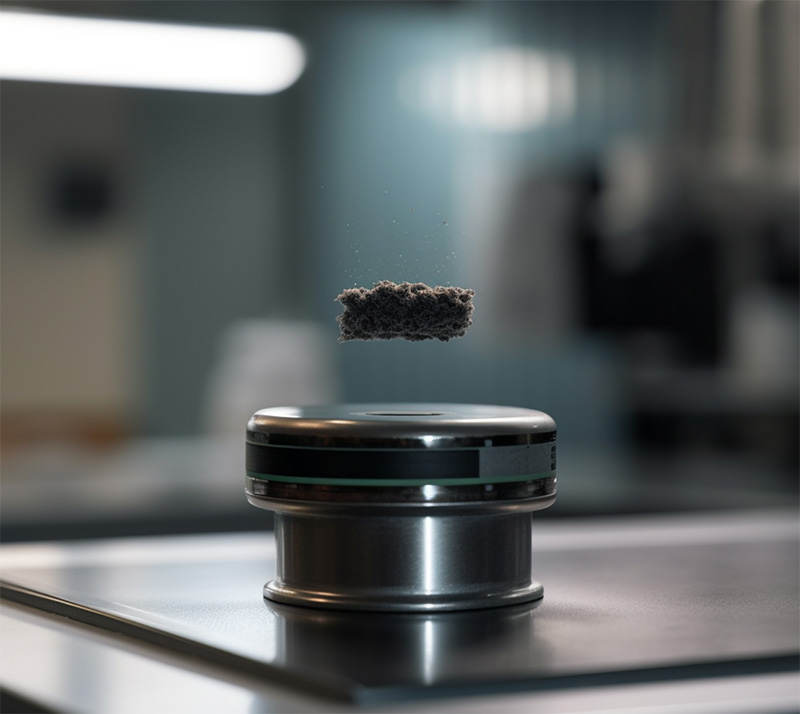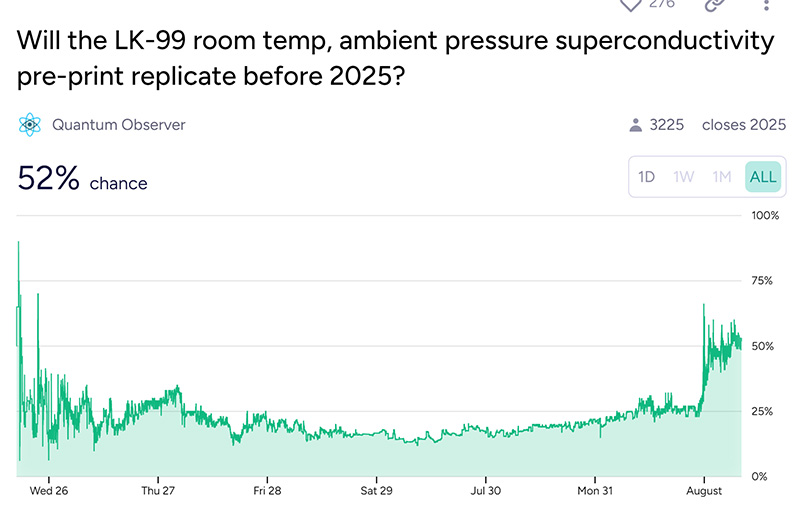The Moment That Could Change Everything
In a dimly lit laboratory, the grey-black crystalline substance sat unremarkable in the petri dish, nothing but a dull rock to an untrained eye. But to Lee and Kim, its crystalline structure could unlock a world of potential and hope. Lee’s gloved hands trembled as he used tweezers to lift the sample, his mind filled with the memories of late nights, failed experiments, and the unwavering encouragement of their late professor T.S. Chair. Today, they hoped to honor his legacy and fulfill a promise that bound them together.
Gingerly, Lee placed the sample onto the round magnet’s metal surface. A tense silence enveloped them, smothering the soft hum of lab equipment. Time seemed to stop as Lee held his breath, released the sample, and watched – as it began to levitate. LK-99 was alive—a room-temperature superconductor, defying all expectations.

AI generated image of LK-99 levitating
The Miracle of LK-99: The Physics World Reacts
The scene I’ve painted might sound like science fiction, but it’s reported to have actually happened in a South Korean laboratory recently. LK-99 (named after researchers Lee and Kim) has enthralled the physics world. Last week, Twitter exploded with reports of a new academic paper announcing that a room temperature superconductor had been created in South Korea.
Or had they? Drama quickly ensued and the best labs and researchers from China to the US raced to replicate the findings. Could it be true? By the time you read this we may know if the most momentous development in physics has actually been corroborated. If it does, Lee and Kim may be in line for the Nobel prize.
Why LK-99 Matters: The Potential Impact
If you’re wondering what all the fuss is about, you’re not alone – I didn’t really comprehend just how big a potential development this is. Room temperature superconductors will allow for a quantum leap in computational speed (and quantum computers). It will transform energy transportation and storage (facilitating decarbonization). It will create a revolution in medical technology (think MRIs etc).
It’s the Holy Grail. Or it’s a fraud. We should know soon. Confirmations are beginning to appear. At the time of writing betting markets are currently ascribing a 52% chance that the results will be replicated. We should be skeptical, particularly where great claims are being made. Still, it’s encouraging to see early efforts at replication bearing fruit.

https://manifold.markets/QuantumObserver/will-the-lk99-room-temp-ambient-pre
We are living in a period of rapidly compounding technologies. If this superconductor material is proven out (a process that will take years to commercialize) it will likely lay the foundation for the age of quantum computing and autonomous general intelligence. LK-99 took Lee and Kim years to create largely through trial and error. With the computational abilities that LK-99 might bring, future scientists will be able to iterate through those processes at the speed of light – who knows how many other superconductors there may be!
The Investor’s Perspective: Navigating Uncertainty
I have no idea whether LK-99 is a legitimate superconductor – even if it is, commercialization will take years. In some respects, LK-99 is not the point – the acceleration of scientific progress and the potential for ground breaking innovation has never been higher. For investor’s that’s the point.
All of this can be a bit overwhelming to investors. Identifying winners and losers is impossible at this stage – for me this is another data point confirming that we are moving at an accelerating pace of technological innovation. We’ve been riding this secular wave for years now – but it appears to be speeding up. This creates a strange anxiety among investors.
Investors have been taught to fear technology. Dystopian science fiction leaves little room in the imagination for technology being a force for good. Canadians as a whole exhibit a high preference for Bank stocks rather than technology stocks despite the abysmal performance comparison shown below. Who among us believes that banks are going to change the world? LK-99 and compounding technologies can.

source: YCharts
No, you shouldn’t sell your bank stocks and pile into technology (certainly not at the moment). Balance is always the key for investing! That said, we need to be aware of our own anti-technology bias – particularly if we are looking to grow our capital. Younger investors particularly should be paying attention!
Exponential Growth: The Power of Compounding Technologies
I’ve told the story before of the inventor of the game of chess, who so impressed an Emperor that he asked for one grain of rice on the first square of the 8 x 8 square chessboard, with the amount doubled on each subsequent square. The request seemed modest at first and the Emperor was delighted to agree to it, but by the time he reached the second half of the chessboard, the amount became astronomical, eventually enough to cover the Earth. This tale illustrates the unexpected power of exponential growth.
Futurist Ray Kurzweil uses this story to illustrate the doubling of computing power. If I’ve done my calculations correctly, we are on the 42 square of the chess board – compute power has doubled 42 times to date. The next doublings are going to appear to be magic.
Embracing the Future: A Call to Stay Curious
We have witnessed two remarkable technological advances in the past 12 months – the broadscale roll-out of AI in Large Language Models and the development of a revolutionary new superconductor. As compute power doubles again, the pace of these innovations will increase. What a time to be alive!
Stay curious, stay informed, and as always, feel free to reach out with any questions or thoughts.
Glen
